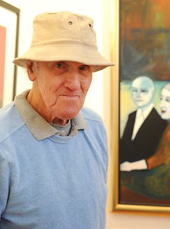
Click an Image below to Enlarge

Robert
Dickerson is famous for being one of that group of artists that make up the
pantheon of "Modern Australian Painting". His name is synonymous with
that of Charles Blackman, Arthur Boyd, John Perceval, Albert Tucker and Sidney
Nolan, as being part of that group that gave figurative Australian painting
it's unique identity - forged in that seminal period from the mid-forties
through to the early sixties.
Born into a poor Sydney household in 1924, Dickerson worked at various jobs
from an early age. His family had a backyard factory in inner Sydney where he
helped in the production and distribution of tin mirror backs. By the age of
fifteen he was working a forty four hour week in a factory in Annandale -
whilst at the same time supplementing his income by boxing professionally under
the pseudo name of Bobby Moody. He was later to travel around the state with
Jimmy Sharman's boxing troupe during which time he endured thirty seven fights
before hanging up his gloves at the age of eighteen.
Dickerson joined the R.A.A.F in 1942. He served on the ground staff in Darwin,
Dutch East Indies and finally on the island of Morotai in Indonesia. Whilst
stationed on Morotai he read Somerset Maugham's "The Moon and
Sixpence" which is loosely based on the life of Paul Gauguin. The book
inspired him to draw the inhabitants of the island in his spare time. This
period was to prove to be an important early step towards his future career as
an artist. There is much in Dickerson’s work that can be compared to
Gauguin’s paintings of the Tahitian islanders - particularly the simplicity of
the drawing, broad areas of pure colours and the paring away of unnecessary
detail.
On his return to Sydney after the war Dickerson took up factory and labouring
jobs for the next ten years; painting and drawing on weekends. During the early
fifties he met and became friends with Charles Blackman along with John and
Sunday Reed who were art luminaries from Melbourne. These contacts were
important in giving him the confidence to pursue more fully, a career as an
artist.
In November 1955, John Reed, in an article in Ern Malley's Journal (Vol 2),
described Dickerson’s work as containing "a new sense of beauty, a new
truth". Then in 1956 Reed gave him his first one man exhibition at the
Museum of Modern Art and Design in Melbourne. According to Dickerson, only two
people turned up to the opening: "One was Arthur Boyd and the other was
John Perceval, who wouldn't go anywhere without his dog, I was very lucky - the
dog liked me"*. His career as an artist was further encouraged when the
National Gallery of Victoria purchased his "Man Asleep on the Steps"
in the same year.
The next big step in Dickerson’s career was his participation in the now famous
(infamous) "The Antipodeans" exhibition held at the Victorian Artists
Society Gallery, Melbourne, in August 1959. "The Antipodeans"
exhibition was posed as a deliberate opposition to abstraction, in the defence
of figurative art. The seven artists who made up the show were: Arthur and
David Boyd, John Brack, Clifton Pugh, Charles Blackman, John Perceval and
Dickerson. These artists never showed as a group again. Dickerson now says that
he was always at odds with the original exhibition manifesto written by Bernard
Smith - he took part because he thought the show was going to travel overseas.**
Included in the 1961 exhibition of Australian art at the Whitechapel Gallery,
London, Dickerson’s career was in full ascendency - he has continued on
throughout the past fifty plus years to cement his reputation as one of
Australia's best known and most loved figurative artists.
The c1966 painting "Reflection" is a classic example of Dickerson’s
work. A moment of reflection playing both on the mood of the figure and the
process of reflection through a mirror (perhaps there is a reference here also
to Dickerson’s early youth as a maker of tin mirror backs). The figure is pared
down to the bare essentials, the drawing economical and the background amorphous
and subservient to the aquiline figure of the woman.
* Robert Dickerson: for the love of art, The Australian, June 28, 2014
Copyright © 2008 Art Nomad. All rights reserved. Click here to view copyright statement